ISSN: 1204-5357
ISSN: 1204-5357
| Daniel D. Singer Professor of Finance, Towson University Postal Address: Stephens Hall, Rm 314, 8000 York Rd., Towson, MD 21252 Author's Personal/Organizational Website: www.pages.towson.edu Email: singer@towson.edu Dr. Singer is currently a Professor of Finance at Towson University and had previously been a Professor of Management at Loyola University (Maryland) and an Associate Professor of Economics at Western Illinois University. He has coauthored Successful Web Portals in Retail Banking as well as numerous other books and scholarly articles. |
| Babu G. Baradwaj Associate Professor of Finance, Towson University Postal Address: Stephens Hall, Rm 314, 8000 York Rd., Towson, MD 21252 Author's Personal/Organizational Website: www.pages.towson.edu Email: bbaradwaj@towson.edu Prior to teaching for Towson University, Dr. Baradwaj taught at the University of Wisconsin Eau Claire from 1990-2001. Before moving to the U. S. in 1983, he worked at a bank in India. He graduated from the University of Madras, India in 1979 with a B.Sc in Physics. His teaching and research interest lies in the area of Banking and Finance. He has taught a wide variety of courses including Financial Policy, Commercial Bank Management, Financial Institutions & Markets, International Finance and Financial Statement Analysis. He has published his research in academic Banking journals including the Journal of Banking & Finance and Journal of Financial Services Research. His work on hostile bank takeovers and interstate bank mergers have been widely cited. |
| Susan Flaherty Associate Professor of Finance, Towson University Postal Address: Stephens Hall, Rm 314, 8000 York Rd., Towson, MD 21252 Author's Personal/Organizational Website: www.pages.towson.edu Email: sflaherty@towson.edu Dr. Flaherty completed graduate studies in finance at the Florida State University. Prior to graduate school, she worked professionally for JPMorgan, MBNA, and as an economic consultant. Her teaching and research interests focus on international finance as well as market regulation, policy, and corporate governance issues. |
| Francis Rugemer Lecturer in Finance, Towson University Postal Address: Stephens Hall, Rm 316, 8000 York Rd., Towson MD 21252 Author's Personal/Organizational Website: www.pages.towson.edu Email: frugemer@towson.edu Francis E. (Ted) Rugemer, Jr., CFA, Lecturer in Finance, Towson University since 1995, Senior Vice President, Bank of Baltimore, 1984-1995. Lieutenant, US Army: 1967-1969; Vietnam Veteran. Research interests include online banking platforms, investment analysis, portfolio management, bank funding and asset/liability management |
| © Daniel Singer, Babu G. Baradwaj, Susan Flaherty, and Francis Rugemer, 2012. |
Visit for more related articles at Journal of Internet Banking and Commerce
The literature on online banking adoption generally finds experience to be a positive factor in online banking use. In contrast, this research suggests a more complex relationship between experience and online banking. Experience is found to have a negative effect on online banking use through its impact on the perceived ease of use (PEOU) and perceived usefulness (PU) of online banking. While counterintuitive, these finding are hypothesized to reflect the fact that greater intensity of use diminishes PEOU because as an individual gains experience with more complex and sophisticated applications in the bank web site, the user becomes increasingly aware of the difficulty of making the most of that technology. It is further hypothesized that greater frequency of use diminishes the PU of a web site because the perception of usefulness of a web site depends on marginal utility, not total utility.
Keywords |
| online banking; retail banking; information and communication technology; technology acceptance model (TAM) |
INTRODUCTION |
| The banking industry in the U.S. remains very challenging. The process of digesting bad loans from the recent financial crisis, the continuing consolidation of the industry, and new financial regulations such as the Dodd-Frank Wall Street Reform and Consumer Protection Act (HLSF, 2010) put bank profit margins under increasing pressure. As the fight for market share and wallet share among the remaining banks heats up, attention continues to focus on the bank’s online banking platform (Bruene, 2011). From the bank’s perspective, the online banking platform provides an excellent low-cost channel for both transactions and building relationships (Boot, 2000; Degryse and Ongena, 2007; Hua, 2009). |
| Consequently, the bank’s response to this situation has been increasing IT expenditures to deliver improved online capabilities (Josefowicz and Mantha , 2011). Up-to-date technology is a necessary condition for a customer’s successful online banking experience in today’s market because consumers are so familiar with Internet technology. Through frequent online experiences, they know what can be done. The main factor in a successful online banking web site is providing the customer with an interface that is focused on the expectations, needs, and desires of the user (Bruno- Britz, 2006; Cooper, 2006). While it is important to have a technologically up-to-date online banking platform, that platform is successful only if it attracts new customers and satisfies the need of its existing customers (Bauer et. al., 2005). Elmezni and Gharbi (2010) have found evidence that website satisfaction has a positive impact on the intention to continue website use. |
| The online banking market is a cauldron of increasing competition driven by consumer expectations and technology. By 2010, almost two-thirds of households report banking online and 80% of banking customers bank online (Bruene, 2011). In 2011, 8.7% of customers indicated they switched their primary banking institution during the past year to a new provider (Burger, 2011). In addition, more than half of the banking customers who purchased a new banking product did so elsewhere than their primary bank. Banking customers are increasingly savvy in searching for banking products and services. The increasing importance of online banking sites is not driven by the need for transactions activity. It is by the need for consumers to sort out complex financial questions. These intense informational needs have been documented as increasing the potential for an online solution to information processing needs (Toker and Varnali, 2009). Banks are well-positioned to be the financial experts that consumers trust for advice on retirement, mortgages and other financial-related life events that can be facilitated by technology. Banks are positioned to support a value creating experience for customers. |
| The result of this highly competitive and dynamic market structure has been increasing pressure on banks to develop websites that create value for their customers. The evolution of bank web sites to their present form has been driven by a series of technological innovations (Bruene, 2005.) The early dramatic pace of change in online banking may have proved an impediment to potential users accepting this new technology (Kalakota, 1998). Online banking web sites will continue to innovate with new technology for the foreseeable future towards increasingly user-centric platforms (Reinhold, 2011). Further, the evolutionary process in electronic banking continues unabated with banks aggressively moving into mobile banking and social networking presenting the consumer with new challenges in technology acceptance (Mohammed, 2010). It may be, as hypothesized below, that this increasing complexity and technological sophistication has a negative impact on the perceptions of online banking users. |
LITERATURE REVIEW |
| As banks began developing primitive web sites two decades ago, technical experts felt that the utility afforded by this innovation would prove sufficiently attractive for individuals to accept and use this new technology. However, the mere potential for being a valuable tool for banking customers was not sufficient to induce adoption. Transitioning from early adopters to the mass market clearly presented banks with major challenges (Moore, 1999). |
| Insight into the acceptance process was given by numerous theories or models. Venkatesh, et. al. (2003) identified eight major models attempting to explain new technology adoption. These models varied in assessing consumer adaptive behavior generally along the lines of the instrumental properties of the technology innovation or through social influence constructs. The Technology Acceptance Model (TAM) has emerged as the most widely investigated model of consumer response to innovative products and has included elements of both instrumentality and social influence (Davis, 1989; Davis, et. al., 1989; Agarwal and Prasad, 1999; Venkatesh, 2000; Venkatesh, et.al., 2003; Benbasat, and Barki, 2007). |
| TAM is an outgrowth of the Theory of Reasoned Action (TRA) in the field of Information Systems. TAM posits that perceived usefulness (PU) and perceived ease of use (PEOU) determine an individual's intention to use a system with intention to use serving as a mediator of actual system use. Researchers have simplified TAM by removing the attitude construct found in TRA from the current specification (Venkatesh et. al., 2003). |
| TAM has a strong behavioral element which assumes that when someone forms an intention to act, that they will be free to act without limitation. The practical constraints such as limited ability, time, environmental or organizational limits, and unconscious habits will limit the freedom to act. TAM addresses the behavior of individuals in confronting the uncertainty inherent in interacting directly with something new— particularly when that something is new because it represents an unfamiliar technology (Davis, Bagozzi, and Warshaw, 1989). The decision to accept, or avoid, the new technology is seen to do with the user’s perception of the technology rather than the new technology itself. In its original formulation, the TAM suggests that an individual’s belief constructs of perceived usefulness (PU) and perceived ease of use (PEOU) fully mediated the influence of external variables on acceptance (Davis, 1989). |
| Further research then extended TAM by introducing factors from related models, by introducing additional or alternative belief factors and by examining antecedents and moderators of perceived usefulness and perceived ease of use (Wixom and Todd, 2005). Attempts at empirically verifying the TAM have led to numerous tests of the TAM model (Benbasat and Barki, 2007; King and He, 2007; Venkatesh, 2000). The general consensus is that the TAM’s belief structures actually predict acceptance behavior in a general sense, but needs to include the impact of individual or contextual attributes on acceptances to new technology (Venkatesh and Bala, 2008). |
EXPERIENCE AGE AND GENDER |
| Individual experience can be thought of as the cumulative result of activity arising from the observation, encountering, or undergoing processes occurring over time (Popper and Eccles, 1977). The implication is that the individual is affected by these experiences and this translates into behavior. Experience as it affects behavior is not the sum of its individual components, but as a coherent whole, as in the German concept of Erfahrung. The influence of experience on our behavior, cognition, emotion, and motivation is both physical though the basic components of the nervous and endocrine systems (Pinel, 2007) and metaphysical as our mental processes shape the meaning of these experiences (Chiou and Wen, 2007). |
| The cumulative nature of experience means that experience results from a dynamic process (Agarwal and Prasad, 1999; Taylor and Todd, 1995; Compeau, 1999). Moreover, the process of acquiring experience appears to involve a complex interrelationship with age, gender, and education (Levy, 1988; Thompson, et. al., 1994; Lorber and Farrell, 1991; Zeithaml, and Gilly, 1987). |
| The formal level of education an individual has accomplished not only provides an individual with greater knowledge per se, but also gives them a familiarity with learning new concepts. An individual does not have to receive training in a specific new technology to be comfortable with using it. Education provides a stream of experiences in accessing new ideas that result in an individual being more familiar with the process of learning. This concept expresses the Progressive School of educational thought (Dewey, 1938). The idea is that experience arises from the result of two principles-- continuity and interaction. Continuity is that each experience a person has will influence their future behavior. Interaction refers to the ongoing impact of situational factors on that future behavior. |
| Age may be thought of chronologically or as a social construct. Systemic differences in Internet usage between age groups arise from differing physical and mental characteristics, labor force characteristics, levels of mobility, levels of educational attainment, income levels and differences in life experience (Mossberger, 2003). Aging may be seen as a multidimensional process of physical, psychological, and social change (Stuart-Hamilton, 2006). |
| A particular concern with the social construct of age is the role of the elderly in society. Advanced chronological age is often considered as a mediating factor in the acceptance of the constantly evolving technology used in online banking. The elderly population is seen to differ from the general population in perspectives and beliefs which affect their attitude about adapting to new technology and consequently, their behavioral intentions. |
| More than 12% of the U.S. population is over 65, a figure that is expected to double by 2030 when they will constitute 20% of the population (He, et. al., 2005). While the number of older people will increase in both absolute and relative terms, Trochia and Janda (2000) found that older consumers are an underrepresented segment of the Internet market. Older people are generally poorer and less mobile than younger people. Older people are likely to have poor eyesight, less physical coordination, and other health issues that lessen their access to the Internet. Older adults are often viewed as less competent and having deteriorated cognitive abilities than younger people (Kwong and Ryan, 1999; Kite and Johnson, 1988). |
| The theory that such individual differences create attitudes and perceptions which modifies the technology acceptance process is well established component of the literature on the Technology Acceptance Model (Agarwal and Prasad, 1999; Bagozzi, 2007). This complex, dynamic process is explicitly recognized in applications of the TAM where the impact of experience on intended usage is seen as interwoven with the moderating effects of age, gender, and education (Venkatesh, 2000; Venkatesh, et. al, 2003; Bagozzi, 2007). |
PERCEIVED EASE OF USE (PEOU) AND PERCEIVED USEFULNESS (PU) |
| Perceived ease of use (PEOU) and perceived usefulness (PU) are understood to fully mediate adaptive behaviors to new technology within the TAM (Davis, 1989; Davis, et. al., 1989; Argawal and Prasad, 1999; Venkatesh, 2000). |
| The moderating factors in determining consumer acceptance to new technologies discussed above are not represented to be either mutually exclusive or inclusive of all factors influencing PU or PEOU. Rather they are seen to represent constellations of major forces that impact PU or PEOU in online banking. PU and PEOU may rest on some shared beliefs, with the line of demarcation between the two constructs less than clear cut (Venkatesh, et. al., 2003). Experience, age, gender, and education are obviously overlapping concepts that impact each other. There is no doubt that other forces may be important in driving PU and PEOU (Venkatesh and Bala, 2008), but these await further research. |
| From the literature review above, experience can be seen as a powerful moderating factor influencing the acceptance toward new technology. In this study, the impact of experience on online banking usage is measured by both frequency of use and intensity of use. |
| Experience with a specific task gives an individual confidence with performing that task and similar tasks successfully in the future. The more visits, the greater the frequency. Frequency of use refers to the degree an experience is repetitive over time. Frequency of use in this study refers to how often an individual would visit an online banking website. Therefore, we define frequency in terms of quantity. |
| Intensity of use refers to the extent a particular website is used. Websites frequently offer an individual the opportunity to access many different functions. Intensity of use in this study refers to how many different functions an individual actually uses at a bank web site. The more functions that are accessed at the bank website, the greater the intensity of use. Therefore, we define intensity in terms of magnitude or level of use. |
| Kam and Riquelme (2007) found a positive relationship between frequency of use and internet banking customer satisfaction. This would follow from the idea the more frequent the visits to a website, the more utility that would be derived from that website. Convenience and efficiency are premium commodities in modern society and highly valued by today’s consumers. An online trip to the bank is an extremely efficient way to perform one’s financial chores from the individual’s perspective. Thus frequent trips to the online banking web site are a sign of the perceived utility of those web sites. |
| Individuals often experience a lot of anxiety over their current or potential financial position in today’s tumultuous world. This anxiety results in stress which most individuals seek to avoid. Thus, the reduction of anxiety related to the frequency of visits to the online banking site creates utility (or the perception of utility) for an individual. Servon and Kaestner (2008) have found that the reason that individuals who use e-banking continue to use it on an ongoing basis results from acquiring a certain comfort level with the technology to keep using it. These considerations imply a positive relationship between perceived utility and the frequency of visitation to online banking sites. |
| Alternatively, consumers have limited resources and time to allocate among many competing activities, products and services. To maximize their total utility, consumers must equate the marginal utility relative to the cost among these competing alternatives (Mankiw, 2008). Given the Law of Diminishing Marginal Utility, increasingly frequent online visits to a bank website can drive down the marginal utility of those visits, even as total utility increases. Thus, it may be possible to observe a negative relationship between the frequency of online bank visits and their perceived utility. |
| It would be expected that PEOU is positively related to the intensity of use (Toker and Varnali, 2009). Experience in successfully using a simple function at an online banking site (e.g., checking account balances) may demystify the use of a more complex function, e.g., transferring funds between accounts. The more functions an individual becomes familiar with, the more likely they are to perceive an increased ease of use (Riquelme, et. al., 2009). In the same sense, intensity may reduce the anxiety associated with the use of different functions and actually increase the individual’s skill in using those functions. |
| Alternatively, given that bank web sites may contain an overwhelming amount of information and many different analytical tools, it is possible that an individual who initially thinks, “This is really easy and fun.” when they first begin to use the website becomes more aware of what they do not know as they use more and more functions at the website. Thus they come to realize with an increasingly intense experience, that their ability to use everything available at the website is limited. Indeed, as they attempt to master more difficult and complex function at the website they may come to feel that using the website is harder than they initially perceived. In addition, many of the functions available at banking web sites are functions that the customer previously handled face-to-face. In the process of being exposed to increasingly complex functions, the customer may reflect nostalgically back to an era when service was more personalized and everything was “easier.” Again, a negative relationship may result as individuals are overwhelmed by the increased complexity of the capabilities of the online site. |
METHODOLOGY |
| A survey of 231 completed questionnaires on online banking behaviors were collected from the target groups located in the Baltimore Maryland Metropolitan Area (USA) in December of 2010 by personal solicitation. Ninety percent of those completing the questionnaire were found to have online banking accounts. Four percent of those with such accounts did not use them. The average age was 34 with the oldest respondent being 93 and the youngest 19. Fifty seven percent of the respondents were males. |
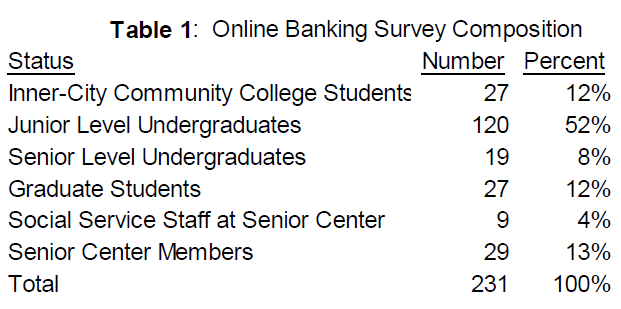 |
| The survey variables are defined and categorized as follows: |
| OBA (online banking account) represented the individual’s possession of an online banking account that was being used (1 if, 0 if not.). All but 3 individuals surveyed reported having maintained the online banking account for at least three months. |
| PEOU was assessed with the question “How easy do you perceive online banking services to use?” and then ranked on a scale of 4 = easy, 3 = somewhat easy, 2 = moderately difficult, 1 = very difficult. |
| PU was assessed with the question “How useful do you think online banking services are?” and then ranked on a scale of 4 = very useful, 3 = helpful, 2 = not very useful, 1 = unnecessary. |
| FREQUENCY of use was assessed with the question “How often do you use online banking services?” and then ranked on a scale of 4 = daily, 3 = weekly, 2 = monthly, 1 = less than monthly. |
| INTENSITY of use was found by summing the various functions (1 if used, 0 if not) the respondents used at their online banking site: (1) apply for a credit card, (2) apply for a mortgage, (3) check account balances; (4) transfer between accounts; (5) pay bills; (6) engage in deposits or withdrawals. |
| GENDER was scored 1 = male, 0 if female. |
| EUCATION was scored according to the educational status indicated in Table 1 above: (0) Senior Center Member and Social Services Staff (55+), (1) Inner-City Community College Student, (2) University Junior, (3) University Senior, (4) graduate Student. |
| AGE was scored by the social construct categories: Young Adults 1 = 19 - 25; Mature Adults 2 = 26 – 45; Aging Adults 3 = 46 – 65; Senior Adults 4 > 65. |
| PEOU and PU were not scored with a Likert Scale (as is commonly done, see Venkatesh, et. al., 2003) to avoid response distortion from a tendency for responders to avoid extremes (central tendency bias) or to agree with a statement as presented (acquiescence bias). Another factor is that Likert scales are ordinal which means there is a tendency for all adjacent pairs to be perceived as equidistant (Bearden, 2011). The category in the middle of an odd-numbered Likert Scale allows a respondent to equivocate about their response. The format used for PU and PEOU in this survey questions forces respondents to reveal their perceptions and is thus likely to be more accurate in measuring those perceptions. |
FINDINGS |
| As may be seen from Table 2 below, frequency and intensity are significantly correlated. This is interpreted to confirm the idea that frequency and intensity are two different dimensions of experience. Frequency and intensity are also positively and significantly correlated with education. Frequency is also significantly and negatively correlated with all the variables representing age. As would be expected from the composition of the sample, age and education are negatively correlated. In the following Logit analysis, the Age Categories variable is used rather than Chronological Age or Age^2 because it is more meaningful as a social construct. |
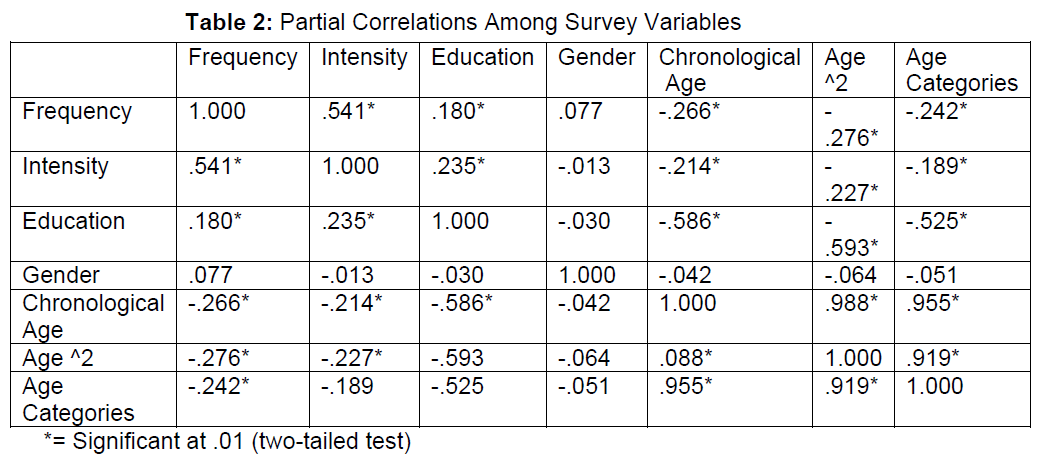 |
| The TAM construct is well defined and explicit. In identifying variables that will be used to interpret the model, it is necessary to examine whether these variables actually conform to this construct. The construct reliability of the variables used in this analysis may be assessed with the Cronbach’s Alpha statistic. Cronbach's alpha will range between 1 and 0. The value is higher as the inter-correlations among the variables increase, thus indicating the degree to which a set of variables measures a single latent construct. It is generally thought if the Alpha statistic is greater than .6, this is indicative of construct reliability (Cortina, 1993; Hair, 2005). Gender is the only variable that did not prove consistent with the other variables. This reflects the fact that gender is found to be irrelevant to online banking behavior in this sample. |
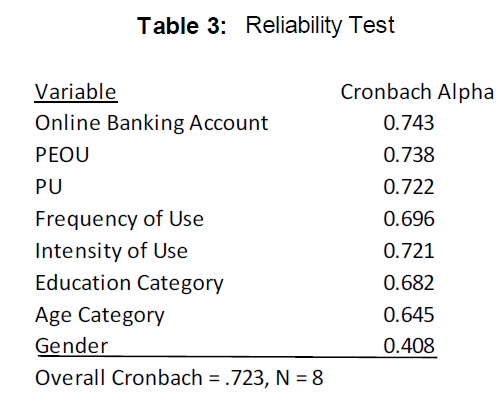 |
HYPOTHESES |
| From the literature survey above, the following hypotheses are tested: |
| H(1) that online banking usage is a positive function of both PEOU and PU. |
| H(2) that PU is a positive function of intensity, and further modified by education, gender and age. |
| H(2a) Alternate: that PU is a negative function of intensity, and further modified by Education, Gender and Age. |
| H(3) that PEOU is a positive function of frequency, and further modified by Education, Gender and Age. |
| H(3a) Alternate: that PEOU is a negative function of frequency, and further modified by Education, Gender and Age. |
| These hypotheses were then tested using Multinomial Logit regressions. The standard OLS regression model was not used because having or not having an online banking account is a binary response variable and the use of a linear probability model in this manner will violate the homoskedasticity and normality of errors assumptions of OLS (Long, 1997). Logit regressions are generalized linear models commonly used for binomial regression. The logit regression works by transposing the binomial variable through a logistic function which will take on values between zero and one. The predicted probability is a transformation of the log-odds. The input is z and the output is ƒ(z) with z may represent the exposure to a set of independent variables, while ƒ(z) represents the probability of a particular outcome. Z thus becomes a measure of the total contribution of all the independent variables used in the model and is known as the logit. |
| The general model is: |
 |
| Hypothesis 1 |
| Testing H(1): that online banking usage is a positive function of both PEOU and PU. |
| The odds ratios in Table 4 represents the likelihood that both PU and PEOU associated with the use of an online banking account and these probabilities were significant at p > .01. Thus, H(1) is confirmed. |
 |
| Table 4 results indicate that when perceived utility increases it is over four times more likely that an individual will have an online banking account. In addition, the odds that an individual will have an online banking account also increases with an increase in perceived ease of use, but not at the same magnitude as the effect of perceived utility. |
| Hypotheses (2) and (2A) are tested in Table 5 and focus on the influence of intensity and demographic factors on the perceived usefulness of the online banking experience. We associate the level of perceived usefulness with intensity, age, gender, and education. We suggest that a negative relationship exist between PU and intensity. As intensity increases, individuals may become increasingly frustrated or overwhelmed by the experience. We anticipate age as an important control variable. Older individuals may have less technology experience and therefore be more easily overwhelmed. |
| Testing H(2): that PU is a positive function of intensity, and further modified by Education, Gender and Age. |
| Testing H(2a): Alternate: that PU is a negative function of intensity, and further modified by Education, Gender and Age. |
| Because PU is coded as a categorical variable (a scale of 4 = very useful, 3 = helpful, 2 = not very useful, 1 = unnecessary), a multinomial logit model is used. The model allows comparison between a base category and each of the other categories. |
| The results of the multinomial logit analysis presented in Table 5 below show a significant and negative relationship between PU and Frequency for all cases of PU both in terms of the logit coefficient and the odds ratio. Relative to the base case of unnecessary, the odds are consistently against the perception of utility at every level of ease. However, no significance is found in the relationship between education, gender, and age with PU. In terms of the adaptive behavior of the individuals surveyed, it may be that frequency subsumes these moderating factors so they do not appear as significant in determining online banking account usage. |
| The key to understanding the negative relationship between PU and the frequency of online banking usage is that the behavior of individuals is valued by the marginal utility received, not the total utility received (Mankiw, 2008). As individuals consume more and more of online banking (as evidenced by their increasing frequency of use), the total utility received may rise, but the marginal utility falls. Marginal utility determines individual behavior because maximizing utility requires an equality among alternative behaviors of the ratio marginal utility to effort expended (cost). |
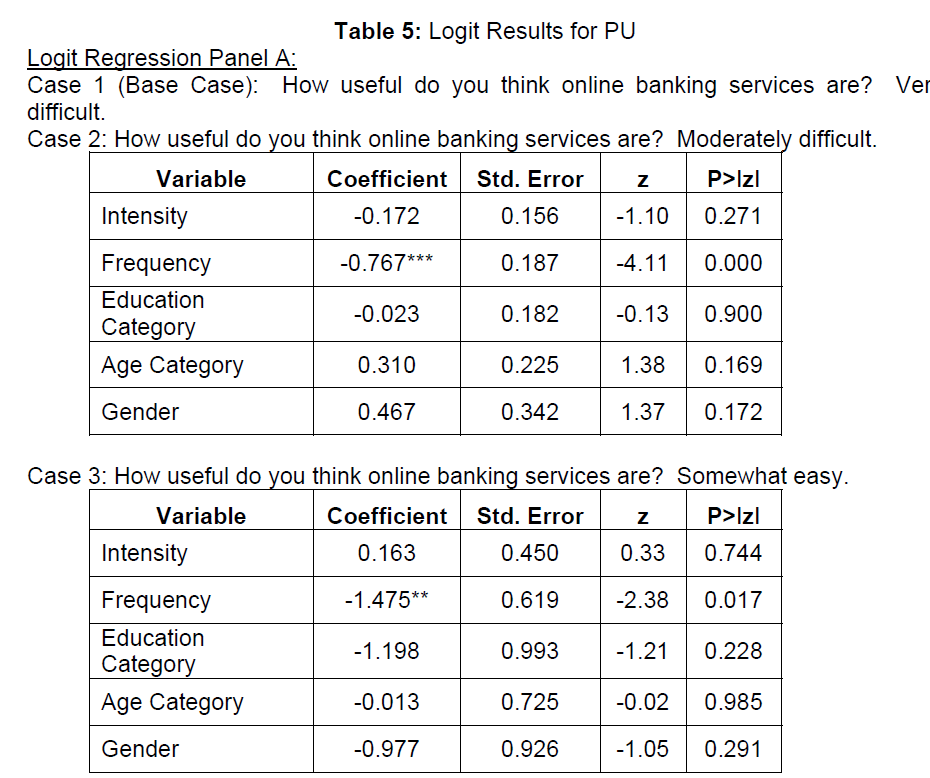 |
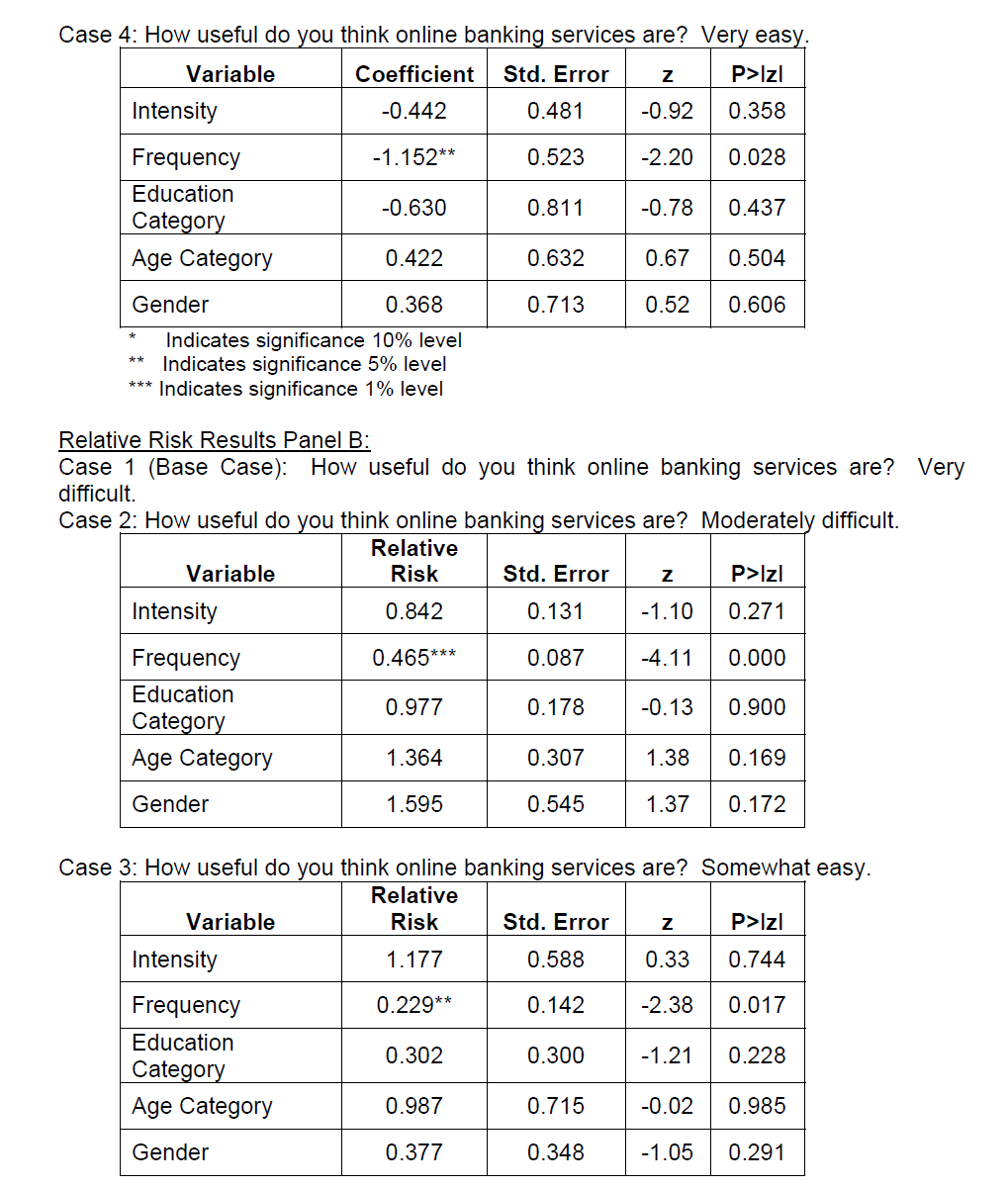 |
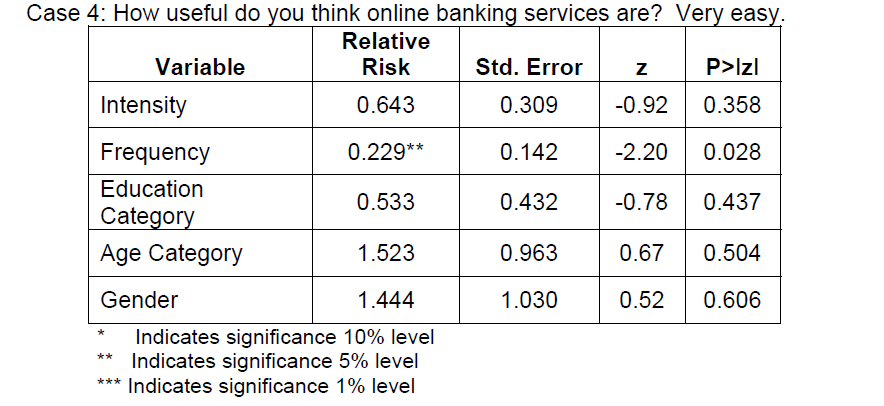 |
| Using the multinomial logit specification, we also assess the relative risk ratio (RRR) of each category. We interpret the relative risk ratio in the following way. For a unit change in the predictor variable, the relative risk ratio of a level of PU relative to the base group of PU (unnecessary) is expected to change by a factor of the RRR value, given all other variables are held constant. The sign of the z value indicates the direction of the predicted change while the RRR value indicates the magnitude of the predicted change. |
| Using PU= unnecessary as the base case, we compare each of the remaining three categories against the base. Regardless of the category relative to the base, the results are the same. Intensity, education, age, and gender are insignificant. Frequency (the number of times an individual accesses the site) is significant. The RRR for frequency compares high frequency users to low frequency users for each category of PU (not very useful, helpful, very useful) relative to the base case of unnecessary. For high frequency users relative to low frequency users, the relative risk for not very useful, helpful, and very useful categories relative to unnecessary would decrease (as evidenced by the negative z value) by a factor of 0.456, 0.229, and 0.229 in each category respectively, given the other variables in the model are held constant. Therefore, the results suggest that individuals who are high frequency users are more likely to indicate the perceived usefulness as unnecessary over other levels of usefulness. Higher usage individuals find the online banking sites less useful. |
| Thus H(2) is rejected and H(2a) is partially confirmed by the negative relationship between frequency and PU. H(2a) is only partially confirmed because Age, Education and Gender did not prove significantly related to PU. |
| Hypotheses 3 and 3(a) examine the relationship between Perceived Ease Of Use (PEOU) and intensity in particular. It also considers the influence of education, gender and age. We suggest that individuals may find their online experience increasingly more difficult the more they try to accomplish on a particular site. |
| Testing H(3): that PEOU is a positive function of frequency, and further modified by Education, Gender and Age. |
| Testing H(3a) Alternate: that PEOU is a negative function of frequency, and further modified by Education, Gender and Age. |
| The results of the Logit analysis presented in Table 6 below reflect a more complex relationship between PEOU, frequency, intensity and age. In case 2 (moderately difficult), frequency does not appear to impact PEOU, but intensity does. This finding suggests that for those least comfortable with online banking an attempt to use more website functions results in greater difficulty and, perhaps frustration, with trying to make all the functions work. Or it may be that this skill is successfully acquired, but it took the user a lot of work to do so. In contrast, in Case 3 (somewhat easy) intensity does not appear to play a role in PEOU, but frequency does, as we observed above in the relationship between frequency and PU. It may be in this case that those with a higher level of computer skills find that PEOU also is subject to the Law of Diminishing Marginal Utility as they visit the banking website more often. |
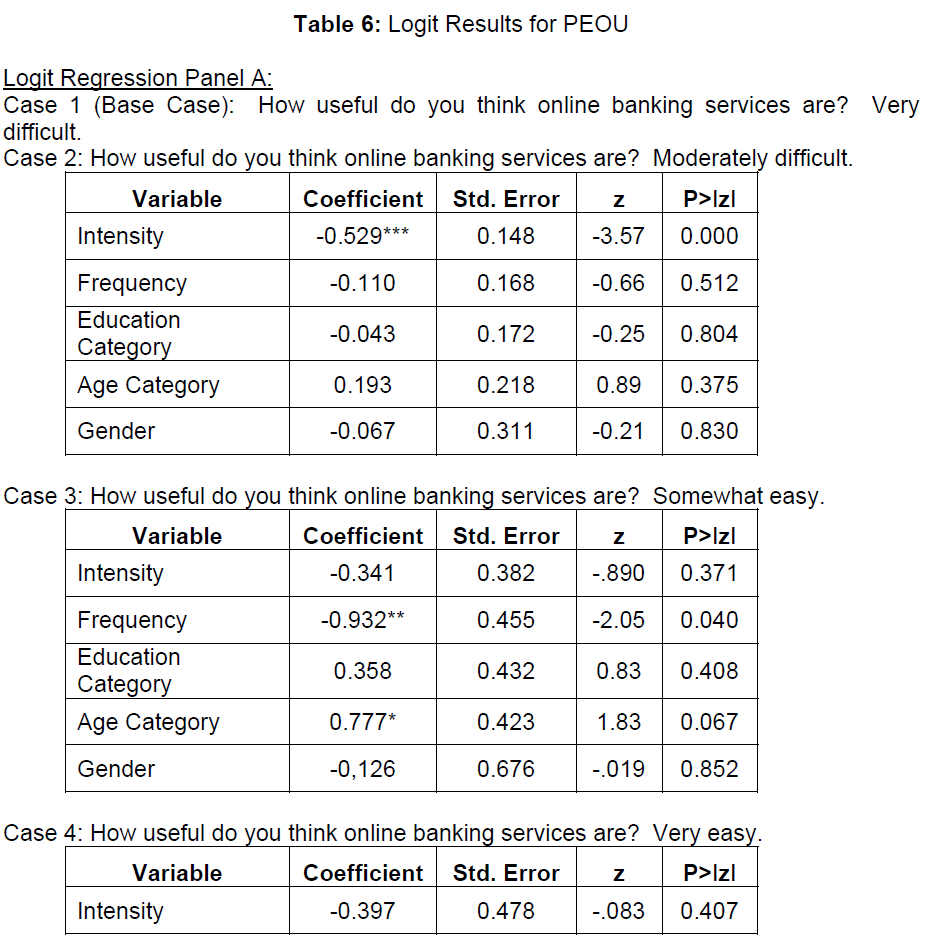 |
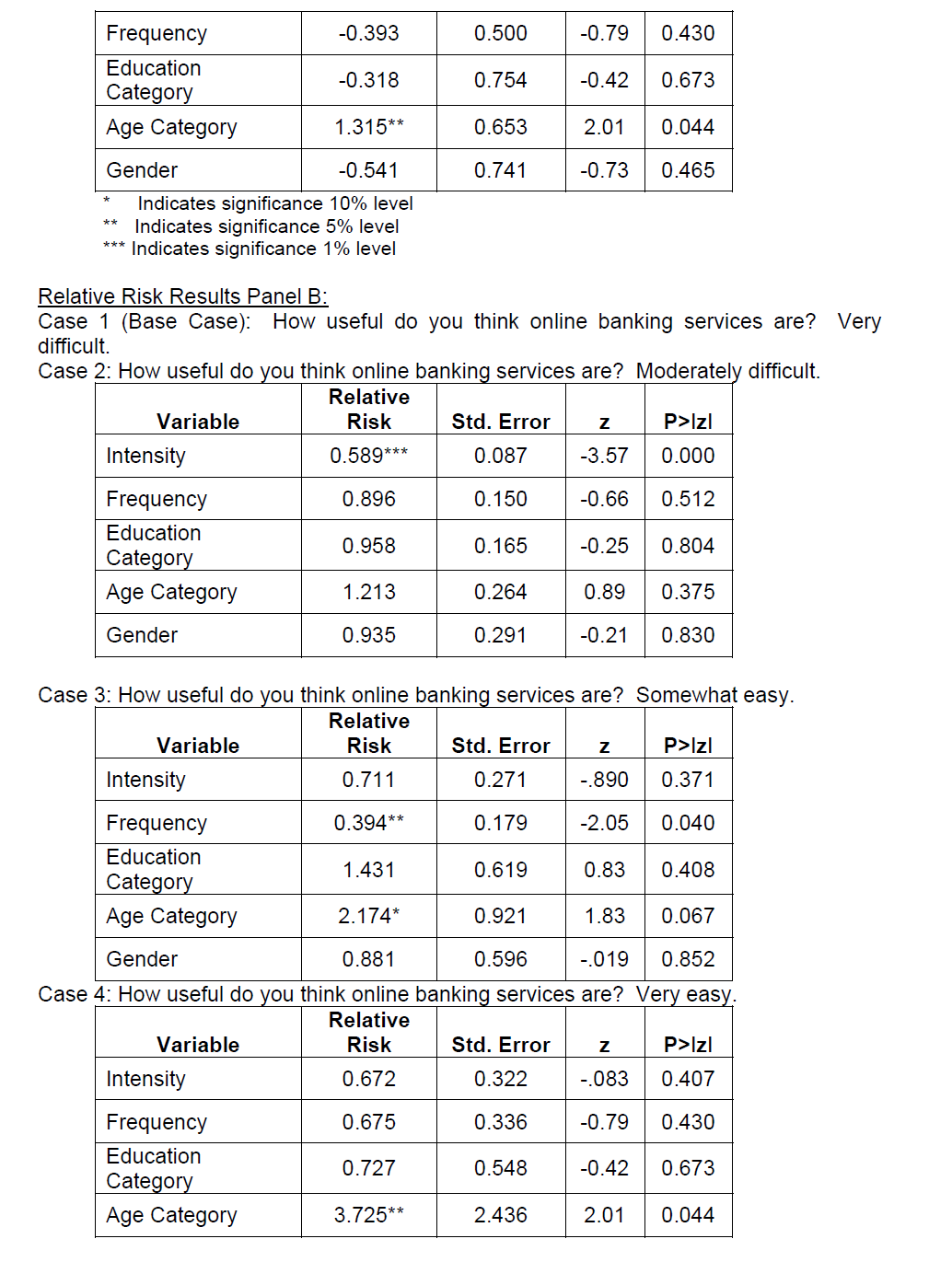 |
 |
| The coefficients in Table 6 Panel A indicate that for high intensity users their likelihood of categorizing their experience as only moderately difficult over very difficult decreases by a factor of 0.589, given the other variables in the model are held constant. When comparing the somewhat easy group (Case 3) versus the base case of very difficult (Case 1), frequency is the only significant variable. The results suggest that for high frequency users relative to low frequency users, the relative risk for somewhat easy relative to very difficult would be expected to decrease by a factor of 0.395. Therefore, higher frequency is less likely to indicate that the experience is somewhat easy relative to very difficult. In comparing the individuals that indicated very easy (Case 4) versus very difficult (Case 1), it appears that age is the only significant factor. As age increases, the relative risk or odds that an individual would indicate the experience as very easy over very difficult increases by 3.725. |
| The negative relationship between PEOU and the intensity of use at the online banking website may reflect other factors as well. Over time banking websites have evolved into increasingly sophisticated and complex tools for financials management. The Wells Fargo banking website offers 18 major categories on its initial screen directly linked to over 40 subcategories which include transferring money overseas, purchasing foreign exchange, rolling over a 401k, investing in stocks and bonds, etc. (www.wellsfargo.com, 2011). Each of these categories link to further services or information that provide a cornucopia of information, which may ultimately prove befuddling to the average user. Thus intensive use may expose a user to more than they want to know or more than they feel comfortable with resulting in a diminished perception of ease of use. Also users (particular older users) may be nostalgic for an era when many banking functions required personal contact. Applying for a mortgage, setting personal financial goals, and discussing estate issues may well be perceived as more easily accomplished when such activities were conducted face-to-face. |
| In the highest category of PEOU (very easy) age was found to be significantly and positively related to PEOU, where as both intensity of use and frequency of use were not significant. This positive relationship between age and PEOU may reflect the fact that aging and senior individuals generally have more limited mobility than the rest of the population and the ability to access their banking functions over the internet is found to be much easier than actually going to the physical location of the bank. As a result, their perception of ease of use refers to a different context than younger people experience. The failure of intensity and frequency to be significantly related to PEOU in Case 4 (very easy) suggests that the individuals in this category have better computer skill sets than those in Cases 2 and 3, so that they are expending less effort on using the website thus avoiding experiencing diminishing marginal effort. |
CONCLUSION |
| Previous literature examining the determinants of online banking use from the perspective of the TAM model has found a positive relationship between online banking acceptance and use and PU and PEOU. This survey finds that relationship to be generally negative and more complex than normally recognized. The implications of this finding are important to banking strategies for acquiring new online customers and for retaining old online customers. As noted above, retaining existing online banking customers is a big challenge for banks. If both the frequency and intensity of the online banking experience are negative with respect to PU and PEOU, merely acquiring an online banking account does not represent a permanent success for the bank. Worse, as the frequency and intensity of website usage grows, the buildup of negative perceptions may cause the customer to migrate to a competitor’s website. |
| These findings suggest two possible approaches to building a more successful website. First, a layering of simple screens that offer an easier path to drill down to more complex functions might be a viable solution. An easier path might involve casting those functions in a more personable and relevant light. Secondly, those initial screens need to be regularly freshened with new material so as to avoid diminishing marginal utility from visitation or use. It is important note that “freshening” such screens should not mean adding greater complexity or additional material to those screens. |
| It should be noted that the findings of this study may not be directly comparable to the findings of earlier research because (1) the social construct of experience is broken down into its components of frequency and intensity, (2) a Likert scale was not used to force customer preferences in order to construct the dependent variable of online banking usage, (3) Logit analysis, rather than OLS, was used to determine the significance of the relationships between experience and PU and PEOU. |
| The negative relationship between perceived usefulness and frequency of use may be generally explained by the Law of Diminishing Marginal Utility. Earlier studies do not distinguish between the total utility and the marginal utility of online banking use to investigate adaptive behavior. The perception of ease of use may also be influenced by the fact that a little learning about an online banking function can open the door to much larger learning challenges. It may be that the skills initially needed to enter an online banking site are easy to acquire, but once at the site, the individual may feel confronted by much more difficult tasks creating a sense of difficulty in using the site. Another possibility is a “nostalgia effect” where the individual finds himself or herself performing tasks on the computer that in a previous era would have been accomplished by personal contact and that experience was in some sense easier than accomplishing the task impersonally on a machine. |
| The highest level of perceived ease of use was found to be positively associated with age. Seniors are well known to generally have less mobility than other population cohorts because of lack of access to transportation or physical disabilities. It may be that the positive relationship between age and perceived ease of use reflects the recognition of internet access to their banking functions relative to the difficulties of physically visiting a bank. |
| The implications of these findings for banks are that in order to make their web sites as successful as possible, they must construct websites in such a manner as to keep the website fresh in the minds of repeat users. Re-runs in television are usually less popular than the original. Why should this be any different for online banking web sites? |
| An additional factor to be considered is that the structure of many bank web sites have become so complex as to create a barrier to further use of website functions beyond the most immediate and simple uses. Viewers need to be made to feel comfortable not only in their initial exposure to the web site, but with each tool or concept. Bank websites currently appear to be constructed with the idea to get as much information to the user as quickly as possible. Instead of exposing customers to an overwhelming barrage of products and services at one time, perhaps a more orderly approach to allowing the user to address their needs would further the perception that the site is easy to use. |
References |
|
Copyright © 2025 Research and Reviews, All Rights Reserved